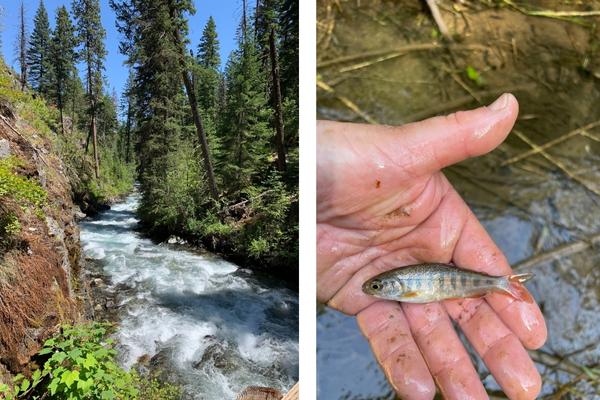
Background
The Small Forestland Investment in Stream Habitat Program (SFISH) is a grant program established by the Legislature in 2022 to help small forestland owners implement projects that result in an environmental benefit to fish or mitigate risks to natural resources arising from the construction, operation or maintenance of forest roads or related activities. The program can fund 100 percent of the cost of eligible projects.
The program is administered by the Oregon Department of Forestry, in consultation with the Oregon Department of Fish and Wildlife. The program helps small forestland owners from project start to finish.
Eligible project types
Projects must benefit fish species covered under the pending
Private Forest Accord Aquatic Habitat Conservation Plan by preventing or minimizing delivery of sediment to streams from forest roads or improving fish passage at road-stream crossings. The three types of eligible road improvement projects include:
- Replacement of culverts or fords that are no longer functioning or do not meet the Oregon Forest Practices Administrative Rules design standards.
- Abandoned road repair.
- Remediation of roads with a perched fill that present a significant hazard to fish-bearing streams.
Photo: Small forestland owners can improve conditions for fish on their forestlands by using the SFISH Program to replace existing road-stream crossings in fish-bearing streams.

Left photo: The SFISH Program provides assistance and can fund 100 percent of the cost for road improvement projects that minimize risks to natural resources arising from forest roads. Right photo: Juvenile coho salmon like this one benefit from properly functioning road-stream crossings and improved water quality.
Fish species covered by Habitat Conservation Plan
Frequently Asked Questions (FAQs)
Who is a small forestland owner (SFO)?
The Forest Practices Act Administrative Rules define an SFO as a landowner who owns or hold in common ownership interest less than 5000 acres of forestland in Oregon, has harvested no more than an average yearly volume of two million board feet of merchantable forest products over the previous three-year period on their forestland, and does not expect to exceed an average yearly volume of two million board feet for the next 10 years (OAR 629-600-0100).
How can I participate in SFISH?
To participate in SFISH, an SFO applies to have their project assessed and placed on a ranking list for funding. The completion of a
Road Condition Assessment (RCA) is also required for participation in the program.
What does the application consist of?
The application is a two-page form that includes your contact information, total ownership acreage, timber harvest volumes over the previous three-year period, basic information for the project site, and a statement of affirmation to maintain timber harvest volumes 10 years after receiving an SFISH grant.
An RCA must also be completed when applying for SFISH if one has not already been completed.
When is the application due?
SFISH applications can be submitted at any time, but to be considered for the first round of funding that is likely to occur in Spring 2024, applications should be submitted as soon as possible.
Who will do the SFISH site assessment?
An Oregon Department of Forestry (ODF) forester in your area will meet with you and conduct an SFISH site assessment. They can also help you complete an RCA if one has not already been completed.
How long will it take for someone to contact me to schedule an SFISH site assessment?
You'll be contacted in the order your application is received. We try to be as timely as possible with every request. If you have not applied for the program, ODF may contact you to apply for SFISH after reviewing an RCA that you submitted when notifying for a forest operation.
How long will the SFISH site assessment take?
The SFISH site assessment time depends on the type of project and complexity of the site. Typically, assessments take between 30 minutes to two hours. Additional time may be required if you need help completing an RCA.
What if the forester determines that my project is not eligible?
If ODF determines that the project is not eligible for SFISH funding your application will automatically be removed from the program, but this does not exclude you from reapplying for future grants for other projects that may be eligible.
How is a project prioritized for funding?
Data collected during the SFISH site assessment will be used to generate an environmental benefit score for your project and a review team will evaluate your project against others waiting for funding.
Who is on the review team?
Review is done by a 5-person team consisting of ODF staff, ODFW staff, and stakeholder representatives.
How long will I have to wait for funding?
You may have to wait for funding, but time waiting for funding is considered when prioritizing projects.
Will ODF do the work for me?
ODF does not have the resources to do the work but can fund 100% of the cost of the work, including both project design and construction. You will be notified of the grant amount when your project has been selected for funding.
What if I want to do the work myself?
ODF will work with you to develop project details. Property owners may be able to do some or all the work themselves instead of hiring it out, but it will depend on the type and complexity of the project.
Are the SFISH Program grant awards taxable?
Any award of over $600 is considered taxable income. Successful applicants will need to include a tax identification number in their grant agreement. You should check the Internal Revenue Service (IRS) guidelines or contact a tax professional to fully understand any tax implications from receiving an SFISH grant.